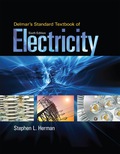
EBK DELMAR'S STANDARD TEXTBOOK OF ELECT
6th Edition
ISBN: 9781305537125
Author: Herman
Publisher: YUZU
expand_more
expand_more
format_list_bulleted
Concept explainers
Textbook Question
thumb_up100%
Chapter 21, Problem 1RQ
Can current flow through a capacitor?
Expert Solution & Answer
To determine
Whether the current can flow through capacitor.
Answer to Problem 1RQ
No, current cannot flow through a capacitor.
Explanation of Solution
Description:
Construction wise, a capacitor is composed of two metal plates separated by an insulating material called dielectric. As there is no closed path available between the plates, the current cannot pass through a capacitor when at rest. However, when a capacitor is being charged or discharged, it gives a closed path, thus allowing current to pass through it.
To summarize, current cannot flow through a capacitor. However it allows current to pass through during the time when it is being charged or discharged.
Want to see more full solutions like this?
Subscribe now to access step-by-step solutions to millions of textbook problems written by subject matter experts!
Students have asked these similar questions
Calculate de currents IaA, IbB and IcC
7.48 Determine the Thevenin equivalent of the circuit inFig. P7.48 at terminals (a,b), given thatVs(t) = 12cos 2500t V,Is(t) = 0.5cos(2500t −30◦) A.
1. In the following closed-loop system, a PD controller of the form K(s + 5) is used. Design the gain K such
that the system achieves an overshoot of 16%. Calculate the settling time and peak time for the PD
controlled system.
Compensator
R(s) +
E(s)
Plant
1
C(s)
K(s+Zc)
(s+1)(s+2)(s+5)
Chapter 21 Solutions
EBK DELMAR'S STANDARD TEXTBOOK OF ELECT
Ch. 21 - Can current flow through a capacitor?Ch. 21 - What two factors determine the capacitive...Ch. 21 - How many degrees are the current and voltage out...Ch. 21 - Does the current in a pure capacitive circuit lead...Ch. 21 - 5. A 30- capacitor is connected into a 240-V,...Ch. 21 - 6. A capacitor is connected into a 1250-V, 1000-Hz...Ch. 21 - 7. A capacitor is to be connected into a 480-V,...Ch. 21 - On the average, by what factor is the life...Ch. 21 - A capacitor is connected into a 277-V, 400-Hz...Ch. 21 - A capacitor has a voltage rating of 350 VAC. Can...
Ch. 21 - A utility company plans to connect a total of 20 F...Ch. 21 - What is the minimum AC voltage rating of each...Ch. 21 - What is the total current flow through the circuit...Ch. 21 - What is the minimum KVAR rating of each capacitor...Ch. 21 - You are working as an electrician in an industrial...Ch. 21 - You are working in an industrial plant. You have...Ch. 21 - Capacitive Circuits Fill in all the missing...Ch. 21 - A 4.7-F capacitor is connected to a 60-Hz power...Ch. 21 - A capacitor is connected to a 208-volt, 60-Hz...Ch. 21 - A 0.47-F capacitor is connected to a 240-volt...Ch. 21 - Three capacitors having capacitance values of...Ch. 21 - A capacitor has a capacitive reactance of 300 ...Ch. 21 - A pure capacitive circuit is connected to a...
Knowledge Booster
Learn more about
Need a deep-dive on the concept behind this application? Look no further. Learn more about this topic, electrical-engineering and related others by exploring similar questions and additional content below.Similar questions
- Find Voarrow_forward3. Use MATLAB to generate the Nyquist plot for the following system. Then, apply the Nyquist stability criterion to determine the range of K values that ensure the stability of the closed-loop system. R(s)+ K C(s) (s+2) 1 (s + 4)(s+6)arrow_forward4. Please find the stability margins from the following Bode diagrams. Bode Diagram Phase (deg) Magnitude (dB) 50 -100 -90 -135 -180 -270 10" 10° Frequency (rad/sec) 10'arrow_forward
- Using Properties to find the Z-Transform including the region of convergence for Sol x(n): = n n cos(0.2(n-2))u(n - 1) Xch]=h+1-1 (1) h+h cos(0.27 (^_1_-1)) * shift → ht 44h-13 can you complete my solutionarrow_forwardFind Ixarrow_forwardJ. na ul-n-1) X (n) = na^ = na^ u(-(n+1)) (1-1+4)= 741-1 4[cn+1)] +1 * Z (^- 1-1 (n-1) a て why ✓ (n) Z , ༥(-༡) ur-n) Znxcm) -Zx X (n) (n-1) a auc-n) = X(n) ぞ 2-9³arrow_forward
arrow_back_ios
SEE MORE QUESTIONS
arrow_forward_ios
Recommended textbooks for you
 Delmar's Standard Textbook Of ElectricityElectrical EngineeringISBN:9781337900348Author:Stephen L. HermanPublisher:Cengage Learning
Delmar's Standard Textbook Of ElectricityElectrical EngineeringISBN:9781337900348Author:Stephen L. HermanPublisher:Cengage Learning

Delmar's Standard Textbook Of Electricity
Electrical Engineering
ISBN:9781337900348
Author:Stephen L. Herman
Publisher:Cengage Learning
Capacitors Explained - The basics how capacitors work working principle; Author: The Engineering Mindset;https://www.youtube.com/watch?v=X4EUwTwZ110;License: Standard YouTube License, CC-BY